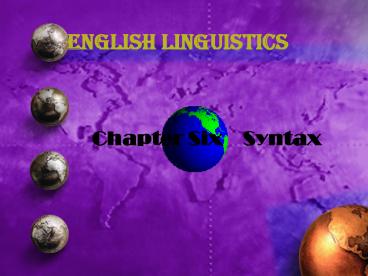English Linguistics - PowerPoint PPT Presentation
1 / 37
Title:
English Linguistics
Description:
A sketch of the minimalist approach to syntax. 1. Syntactic relations ... Numeration {see, v, T, Peter, David} Peter saw David. Derivation. Step 1. see [V,uN] ... – PowerPoint PPT presentation
Number of Views:138
Avg rating:3.0/5.0
Title: English Linguistics
1
English Linguistics
Chapter Six Syntax
2
Syntax
- Syntax is the study of how words are combined
with others to form sentences and in what - order.
3
Syntactic relations
Basic patterns of word combinations
Immediate constituent analysis
Deep and surface structures
Syntactic rules
A sketch of the minimalist approach to syntax
4
1. Syntactic relations
Positional relation and relation of
substitutability
1.1 Positional relation
Sequential arrangement of words or word order in
a language.
The dog bites the man.
The man bites the dog.
Canis mordet hominem. Canis hominem
mordet. Hominem mordet canis. Mordet canis
hominem.
1.2 Relation of substitutability
He (Tom, Mary) cries (shouts, smiles).
5
2. Basic patterns of word combinations
The subject-predicate pattern
The relationship between the subject and the
predicate.
These American students are working in the lab.
The verb-object pattern
The relationship between the action of the verb
and the object to the verb.
To write a research paper.
6
Linguists use different function labels to
describe subjects and objects to suit different
needs
Agent
Theme
Beneficiary
Goal
Instrument
Experiencer
(1) The key opened the door.
Instrument Theme
(2) The dog died .
Theme
(3) David sent the parcel to the aged relative .
Agent Theme
Goal
7
Three kinds of subjects
grammatical, logical and psychological.
A grammatical subject
A noun which can establish correspondence with
the verb and which can be checked by a
tag-question test.
John likes linguistics the most, (doesnt he?)
A logical subject
The doer of the agent or action involved.
The dog was kicked by the boy.
A psychological subject
The subject matter that the speaker has in
starting his remark.
8
Red is the east.
9
3. Immediate constituent analysis
Immediate constituent (IC) analysis
Describing a sentence up into its immediate
constituents by using binary cuttings until
obtaining its ultimate constituents .
A top-down approach
10
(No Transcript)
11
IC analysis can help
to account for ambiguity of certain
constructions.
Visiting aunts can be boring.
(1)
(2)
12
ambiguous sentences
IC analysis difficulty
(a) The shooting of the hunters was terrible.
(b) Flying planes can be dangerous.
(c) Time flies.
(d) John loves Richard more than Martha.
(e) The police were ordered to stop drinking
about midnight.
13
4. Deep and surface structures
Every sentence has two levels of structure.
One ,which is obvious on the surface , is called
surface structure, and the other, which contains
all the units and relationships that are
necessary for interpreting the meaning of
the sentence, is called deep structure.
Chomsky
The love of God
Someone loves God
God loves someone
14
5. Syntactic rules
The rules which determine what morphemes and
words are combined into larger grammatical units
and how they are put together in a sentence are
the syntactic rules of the language.
Transformational-generative (TG) grammar
provides a model for the description of such
syntactic rules.
15
5.1 X-bar theory
5.1.1 X-bar theory and lexical categories
16
pp
at the meeting
of the event
17
5.1.2 X-bar theory and non-lexical categories
5.1.2.1 Nonlexical categoryTP
18
5.1.2.2 Nonlexical category CP
19
5.2 Transformational rules
Common types of transformations
deletion
substitution
movement
insertion
20
5.2.1 Deletion
A Where have you been? B To the park.
(Deep structure I have been to the park.)
5.2.2 Substitution
Jane hurt herself. (Deep structure Jane hurt
Jane.)
21
5.2.3 Movements
5.2.3.1 Inversion
(1)
(2)
22
5.2.3.2 Wh-movement
23
(No Transcript)
24
5.2.4 Insertion do-support
Insert do into an empty T position.
T
V
N
lunch
25
5.3 Constraints on movement
Compare (1) and (2)
(1)
(a) How do you think (that) Peter solved the
problem? (b) CP How do TP you think CP
that TP Peter solved the problem t
(2)
(a) How do you wonder whether Peter solved
the problem? (b)CP How doTP you
wonderCP whetherTP Peter solved the problem
t
26
Similar island constraints in Chinese
- ??????????
- (b)??i????ti????
(1)
- ?????????
- (b)????????????
(2)
27
5.4 Parametric variation
5.4.1 Head-complement order
Head parameter
(a) Head-first
(b) Head-last
(German)
(English)
28
5.4.2 The Wh-movement parameter
What did you buy? CP What did TP
you buy t
?????? What did you buy?
Kimi-wa nani-o
kaimasita ka? You-TOP
what-ACC bought Q What did you buy?
29
6. A sketch of the minimalist approach to syntax
6.1 I-language
A speakers I-language is his or her tacit
knowledge of their native language.
6.2 A minimalist theory of I-language
30
6.3 Features and Full Interpretation
6.3.1 Types of features
Interpretable and uninterpretable features
6.3.2 Full Interpretation
The structure to which the semantic
interface rules apply contains no uninterpretable
features.
31
6.4 Checking and derivation
6.4.1 Checking
(1)
Checking under sisterhood An
uninterpretable c-selectional feature F on a
syntactic object Y is checked when Y is sister to
another syntactic object Z which bears a matching
feature F.
32
(2)
Checking under Agree An uninterpretable
feature F on a syntactic object Y is checked when
Y is in a c-command relation with another
syntactic object Z which bears a matching
feature F.
(a) Jane misses David. (b) Jane missed David.
(c)TpresentVv upresent
(d) TpastVv upast
33
6.4.2 Derivation
Peter saw David.
Numeration see, v, T, Peter, David
Derivation
Step 1
34
Step 2
Step 3
35
Step 4
Step 5
36
Step 6
37
Thank you































